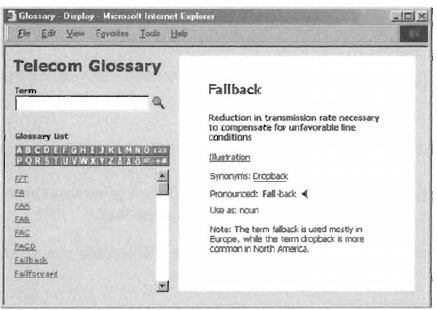13.3. GLOSSARIES
A glossary defines terms and guides readers in their use. Most Web-based glossaries are really what most people call dictionaries, but their usefulness goes beyond what we call them.

Here is an example of a sophisticated Web-based glossary. It contains terms from the telecommunications industry. Users can look up terms by two methods. Users who know the spelling of the term can type in the term in the text box at the upper left and click the search button beside it. If the term is found, it is displayed in the area to the right.
Or users can click on a letter button to see a list of terms beginning with that letter. Once they find the term in the displayed list, they can click on it to display its definition and other details. In addition to the definition, this example includes:
A link to an illustration. The illustration, of course, could have been displayed here instead.
Synonyms and other related words, each linked to its definition.
Pronunciation, both spelled out in text and linked to a voice pronunciation.
Part of speech of this word.
Usage notes to help the reader use the term appropriately.
To find more examples of glossaries, search the Web for glossary or dictionary.
13.3.1. When to create a glossary
A glossary makes strange words familiar and guides us in their use. It can teach concepts, as well. Consider creating a glossary for areas in which:
Practitioners ...
Get Designing Web-Based Training: How to Teach Anyone Anything Anywhere Anytime now with the O’Reilly learning platform.
O’Reilly members experience books, live events, courses curated by job role, and more from O’Reilly and nearly 200 top publishers.

